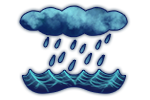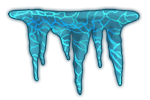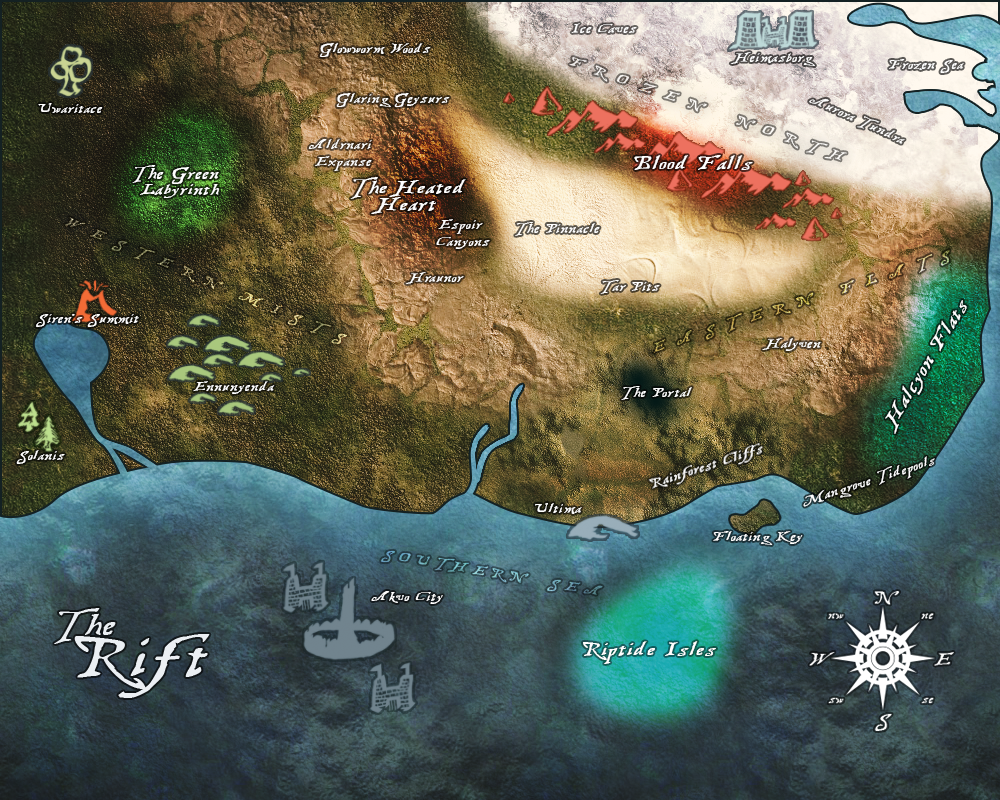- The Beginning
- Lore
- Geography
- Systems
- Extras
- Credits
|
Seasons
  
There are 3 seasons in the Rift: Scorch, Drench, and Freeze.
Each season lasts 3 real-life months. One IC year lasts 9 real-life months.
Read below for more information about each season.
Scorch

Scorch marks the beginning of the Rift’s year with long days and hot days. It is the only time true sunlight touches the Rift— but it is not a pleasant experience for many. The only light strong enough to light this shadowed world is so powerful that the heat desiccates and burns. The intense, relentless rays abruptly melt the ice and snow of Freeze; and, for a brief period in the early season, the moisture from the melt allows plant life to flourish. The bloom is short lived, however, for as the days grow to unbearable lengths and heat, the Rift is scorched dry.
Abnormal Phenomena:
- Scorch Wildfires - As the unrelenting sun shines down onto the lands, temperatures can rise to unbearable heights. This heat can become so concentrated that it causes the very magic in the air to combust. These infamous Scorch Wildfires are hallmarked by black fire, which strikes terror to any who have been caught in their path. These dark tongues of flame burn only magical flesh, often leaving a trail of dead bodies in their wake.
- Scalds - A type of sunburn unique to the Rift’s Scorch, it is so named because the burn appears as intense and blistered like boiling water was held against the skin. Unlike normal sunburns, it has no predilection for pale skin and is, instead, associated with particularly intense rays that randomly disseminate from the Scorch’s extreme sun. Also unlike normal burns, when the Scalds heal, they leave behind thick white skin that absorbs sunlight and softly glows at night.
Normal Phenomena:
- Fires - In addition to the Scorch Wildfires, regular fires also combust across the land, sometimes started by a rogue heat-lightning strike or a poor use of magic. Fires are deadly and swift, often trapping unsuspecting animals in a fiery death. They also smolder for days and can spread by 'jumping' with the winds. Even those clear of the flames may suffer from smoke inhalation.
- Heat Lightning - So great is the energy in the hot rising air of Scorch that it will occasionally discharge as lightning across the cloudless skies. Although the huge, branching patterns are terribly beautiful to behold, an occasional stray prong can start conflagrations that sweep across the Rift.
- Insects - The season's dryness causes insects of all kinds to seek out any kind of moisture, especially from eyes, nostrils, lips, and even blood. This provides a constant annoyance all parts of the day, and many horses will stand side-by-side, rump-to-head to use tails to swat away bugs. Continually biting can lead to open sores, and insects also will worsen pre-existing injuries by biting, irritating, and laying eggs in wounds. They make wounds more likely to become infected.
- Heat - Scorch’s long days bring intense heat, which can cause an assortment of issues. It also leaves hides slick with sweat and stained with salt. Remaining hydrated during the season can be a challenge.
Health Effects:
- Anhidrosis - Intense heat causes sweat; however horses that sweat too much for too long eventually lose the ability to do so. This is called 'anhidrosis' or 'non-sweating.' The inability to sweat is quite dangerous, making a horse prone to overheating. Remaining in or near water sources as well as avoiding being active in the hottest parts of the day will help avoid this dangerous condition.
- Overheating - Overheating, also known as hyperthermia or sunstroke, occurs when the body exceeds temperatures compatible with life. In Scorch’s hot, dry days this can easily happen, leading to dizziness, confusion, seizures, and death.
- Sunburn - In addition to the Scalds, Scorch’s intense sun rays can cause severe burns on exposed skin (such as on the muzzle and around the eyes). Though it usually affects only those horses with pale, unpigmented skin. Redness, tenderness, and blisters are all hallmarks of intense sunburns. Mud, dirt, and shade all act as natural sunscreen to protect the skin.
- Hoof Bruising - The dry weather and soil leech moisture out of hooves, making them very hard and brittle. This not only makes them easier to crack and break, but also makes them prone to bruises from any hard or uneven surfaces. While painful to walk on, hoof bruises usually heal within a week.
- Shedding - Thick winter coats from Freeze begin to shed as the season quickly heats with Scorch’s incessant sun. This leaves many coats looking messy with clumps of long and short hair in the early season; however, by the end, most are sleek and thin due to the relentless heat.
Drench

What may be a relief from the Scorch’s heat quickly turns into a nightmare of flooding, torrential rain, and never-ending moisture. In the early parts of the season, the dried and parched earth thirstily soaks up the dumping moisture from the skies, causing an abundance of green growth. However, as these never-ending, heavy clouds continue their deluge, they inundate the Rift causing dampness and wetness pervade all living things. Days gradually shorten throughout this season, though it is hard to tell for the thickly clouded skies often cast the lands into a permanent darkness. By the end of the season, a film of moisture drenches the entirety of the Rift.
Abnormal Phenomena:
- Drench Floods - With the constant rain of Drench, waters all around the Rift rise. Being a land doused in magic, this extreme weather can lead to the dreaded, deadly magical Drench Floods. These water-muddied waters appear normal enough at first; however, being full of dense magic, it makes the apparent liquid feel like syrup. Once caught by one of the Drench Floods, getting away may prove extremely difficult… and inhaling this magical syrup maybe the last thing you do.
- Thunderbolts - While regular lightning and thunder are common occurrences throughout Drench, the infamous Thunderbolts are a rare (but unmistakable) phenomenon. The telltale sign that these bolts are about to hit is upside-down rain, the droplets drawn towards the magnetic magic the Thunderbolts create in the clouds. After the warning of reversed droplets, the Thunderbolt will strike earth as a thick shaft of blinding white electricity. Drawn towards magic (the way lightning is drawn towards metal), the Thunderbolt remains in contact with whatever it strikes for long minutes; its magical magnetism pulling out magic towards the sky. Occasionally, the large bolt will become tinged with colors of whatever magic it draws out.
Normal Phenomena:
- Hurricanes - These circular and rotating storms, known as hurricanes, arise over the warm Southern Sea. They wreak havoc on ocean life, before bringing intense winds, storm surges, and pelting rains raging against the coasts. These dangerous storms may leave destruction in their wake.
- Monsoons - These are the telltale rains of Drench, bringing continuous and intense rain storms that sweep across the land. If not careful, one may be trapped by swelling rivers or lakes during these intense downpours (sometimes dropping feet or meters of water). Pay particular attention for Drench Floods during these Monsoons.
- Mudslides - As the season rains on, soil becomes muddy and moisture-laden. In areas with any kind of elevation change, this can lead to a loosening of soil and resultant mudslides. Extremely dangerous, mudslides turn earth into liquid-like sludge, wiping out life of all kinds in its path.
- Flash Floods - In addition to Drench Floods, normal flooding also occurs during Drench. Sudden, intense flooding that may happen in a matter of moments either early in the season when heavy rains overwhelm desiccated soil, or late in the season when the soil cannot absorb any more water. These quick and unexpected deluges overwhelm the land, sweeping away any and all life near its rushing water.
- Mud - The constant wetness leads to an overabundance of mud, especially at the end of the season. This can lead to slipping, as well as coating limbs and bellies. Skin coated with mud for too long can become soft, easily rips, and is prone to fungal or bacterial infections.
Health Effects:
- Founder - New shoots of grasses and shrubs that greedily drink and grow in the moisture are filled with sugars and nutrition. However, the abrupt change from Late Scorch’s sparse forage may overwhelm a horse’s intestines, which (through complex biological pathways) lead to severely painful hooves (also known as laminitis). If not careful, this can be a deadly disease, so soaking hooves in ice or cold water will greatly help with the pain!
- Parasites - A return of wetness and life also means a return of intestinal parasites, especially since all life is voraciously eating the newly growing food. Many dormant eggs begin hatching, sometimes causing stomach aches or general illness. An overload of parasites will lead to dull, shaggy coats, a skinny body, and a pot-bellied appearance.
- Fungus - Drench’s general moistness creates the perfect conditions for fungal growth. Not only in the environment, but also on the body. Continually wet skin makes it prone to to fungal invasion, often causing the skin to become crusty, itchy, and slough off.
- Thrush - Constantly wet soil and conditions makes the hooves continually damp. This leads to a condition known as 'thrush,' a smelly white bacterial infection of the feet. Though not extremely dangerous, it may make hooves tender and sensitive.
Freeze

Though drier than Drench, Freeze is hardly a reprieve. Any moisture is quickly turned solid by the dangerously frigid temperatures. As the clouds relinquish their captive skies from Drench, the incredibly short days are acutely evident. The wan sunlight does little to relieve the coldness that quickly cuts through even the thickest of coats. Long, icy nights send frost deep into the land, while short days often dump snow or sleet across the Rift. Most life struggles to outlast this frigid season, going either dormant or hibernating and leaving the earth rather barren. Those bold or unfortunate lives that brave Freeze are often found entombed in sheets of clear ice.
Abnormal Phenomena:
- Freeze Snowfalls - The absolute cold of Freeze will frequently turn the magic in the very air to snow. When it falls, it appears like regular snow; however, it stings the flesh like acid. The wounds inflicted by these snowfalls do not heal until the warmer temperatures of Scorch. Luckily, there are never acid snow blizzards, only small flurries.
- Living Ice - A slow killer of Freeze, Living Ice is (thankfully) rare in the Rift. Appearing like normal ice, except for an easily missed neon aura, this unusual ice is drawn towards magical life. Moving slowly and gradually, it coats and entombs life in sheets of clear, thick ice. However, due to its sluggishness, it usually can only trap small, sleeping, or already-hypothermic creatures.
Normal Phenomena:
- Predators - Due to a lack of prey, predators that do not hibernate grow more vicious and dangerous. In their hunger, they will hunt any prey. The young, elderly, and sickly are the most at risk from these attack.
- Snow/Ice - In addition to Living Ice, normal ice is a major concern during Freeze, as it can coat the body, make surfaces slick for walking, and pack in the hooves. Thickly grown winter coats layered with ice predispose characters to hypothermia. Slick, icy ground is treacherous for traversing and can easily cause careless individuals to break limbs or strain tendons. Hooves packed with ice often lead to bruises and soreness, though the numbing quality of ice can mask injuries until they are greatly exacerbated by use.
- Blizzards - Intense Freeze storms can escalate into blizzards, which have sustained high winds. It is not uncommon for blizzards to last from hours to days. They not only lay down snow and sleet, but the winds also blow existing snow, leading to whiteout conditions with no visibility. Due to the cold winds, hypothermia and frostbite are serious concerns in this weather.
- Avalanches - In areas with any appreciable elevation change, avalanches are an impending threat. Usually occurring after serial freeze-thaw conditions, these massive slides of snow, rock, and debris are extremely dangerous and often strike with little warning. In more mountainous regions, avalanches can be triggered by characters or animals walking across large snowpacks, burying them alive and causing destruction below.
Health Effects:
- Hypothermia - Hypothermia (or a severe drop in body temperature) is an insidious threat during Freeze, gradually taking victims who are exposed to the elements or unprepared for cold weather. Beginning with shivering and confusion, it progresses to stumbling, extreme confusion/stupor, and finally death.
- Frostbite - Affecting distal extremities, frostbite usually affects those who spend extended periods of time exposed to the cold elements (such as in blizzards). Starting with itching and pain, it will progress to blistered skin and finally dead tissues (needing amputation). The ears, muzzle, and distal limbs are most often affected.
- Snow Blindness - Snow blindness is a painful, temporary loss of vision due to extended exposure to ultraviolet rays (essentially 'sunburning' the eye). This will most commonly affect those in higher altitudes, where the sun's light is strongest; but it may also affect any who spend too long looking over snow in sunny conditions. Depending on severity, blindness can last anywhere from hours to days and may have permanent effects on vision.
- Starvation - There is a substantial lack of forage during Freeze, thus all animals are subject to starvation. In equids, the lack of food can lead to stomach ulcers forming as well as other intestinal blockages/upset.
- Thirst - Since most water sources are frozen over, many will resort to eating snow to remain hydrated. However, cold body temperatures may prevent one from being able to stay entirely hydrated this way. Also, some snows may contain bacteria that cause illness when ingested.
|




















